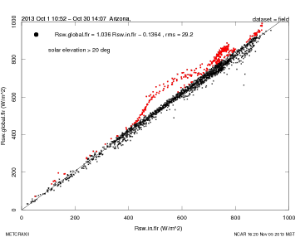November 4, twh.
The FLR radiometers were not cleaned as often at the radiometers outside the crater and the upfacing pyranometer had periods of several days when it was contaminated with bird droppings while the SPN1 reportedly was not. The question arises, how well did the SPN1 measure global incoming shortwave radiation?
I begin with a comparison of the SPN1 global radiation to Rsw.in from the K&Z CM21 at NEAR.
I need a latitude and longitude for editing the solar radiation data by sun angle.
Cannot currently access the GPS lat/lon, so use those measured by Oncley at the end of the project. This is not all that critical for FLR and NEAR.
For the FLR radiation stand, SPO measured
latitude = 35d 01.680' = 35.028
longitude = 111d 01.353' = -111.05588
Then
At NEAR, select data with sun elevation greater than 15 degrees (this limit is not critical). The median ratio of Rsw.global/Rsw.in = 0.9938. I note, however that there is hysteresis in the plot of Rsw.in.global versus Rsw.in. This is consistent with the observation that the up-facing radiometers at NEAR were not perfectly leveled because of problems with the radiometer mounting device.
:



